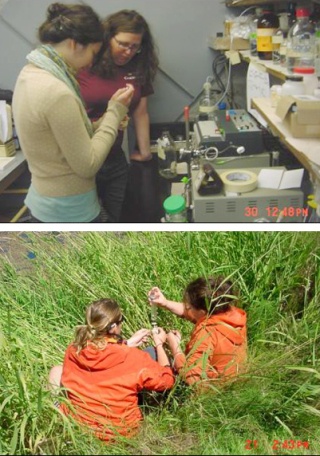Six local high school and college students spent their summer taking water quality samples at 32 sites on Lopez, Orcas and San Juan islands.
Funded by the San Juan Nature Institute, the students analyzed the samples at the U.W. Friday Harbor Labs. Aided by Russel Barsh of Kwiaht and Dr. Jack Bell, they designed a sampling protocol, learned analytical methods, tested matched sets of sediment and water samples, and collaborated on a final report.
What did they find? Levels of surfactants (detergents) in all but one sample that are high enough to harm fish and other aquatic wildlife. Surfactants are what make soaps, shampoos and other household cleaners foam. In addition, only two sites, Killebrew and Diamond lakes on Orcas Island, didn’t have measurable pyrethroids, the most common active ingredient in household and garden pesticides, which in high-enough concentrations can also harm fish and other aquatic wildlife.
During the weekly chemistry seminars this summer, two college students from the islands acted as mentors to those still in high school. Hannah Halliday is from Orcas and attends Western, while Marie Clifford is from Anacortes and attends the U.W. They coached high school students Geneva Mottet from San Juan, April Holland from Lopez who is now attending MIT, and Tasha and Arielle Wilson from Lopez, both of whom are now attending Whitman.
As summer chemistry interns, the six of them put in a total of 1,280 volunteer hours helping to get a handle on the state of surface water quality in San Juan County.
It was a very rich training environment with many cross benefits. Students enjoyed getting outside visiting sites all around the islands, working in a “real” chemistry lab, and participating in a project that had relevance to their communities. All of the students felt they learned skills that would help them in college and later in their professional lives.
Their essays reflect how deeply this opportunity impacted them.
“It has been an exercise in perspective learning the processes of environmental chemistry at their most minute and technical, while discovering the incredible impact human beings have on a planetary scale,” Clifford wrote. “Sometimes science means getting your feet wet and getting a little dirty if that’s what it takes to get what you need!”
Halliday wrote, “My take-away message was of the environmental impacts from household chemicals, especially soaps and detergents. I had never considered the effect that surfactants could have on the environment, and I was shocked at how prevalent they are, and how little of them need to be present for biological impacts to emerge. Since working on the project I have dramatically cut down on the amount of detergents I use in my household, and have switched to products that are biodegradable and environmentally friendly.”
Barsh gave a report to the County Council Oct. 28 summarizing the test results. Students Clifford and Halliday will return to the islands to help conduct two sets of public water quality workshops coordinated by San Juan Nature Institute this spring on Lopez, Orcas and San Juan islands. Barsh will train participants on how to properly collect samples, among other topics.
Workshop dates will be published in the local newspapers, online, and at the Nature Institute’s Web site, www.sjnature.org.
This project is sponsored by a Public Participation Grant from the state Department of Ecology.



